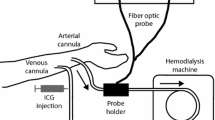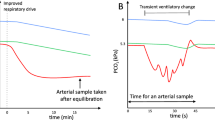Abstract
Objective.We have previously described an indicator dilutiontechnique of measuring cardiac output in which lithium chloride is injectedas a bolus via a central venous catheter and cardiac output derived from thearterial lithium dilution curve recorded from a lithium-selective electrode,which we have developed for this purpose. It would be an advantage if thelithium could be injected via the basilic vein (in the antecubital fossa) inthose patients who do not need central venous catheterisation for otherreasons. We have therefore compared cardiac output measurements made usingthese two routes of lithium chloride administration. Methods.Lithiumdilution cardiac output was measured 10 times in each of 10 patients,injecting the lithium chloride alternately via the basilic or central venouscatheter. Results.The mean difference was 0.8 ± 5.2% (SD)(range −8.5 to +7.0%) over a range of cardiac output of 4.5–13l/min. Conclusions.Injection of lithium chloride via the basilic veinin the antecubital fossa allows accurate lithium dilution cardiac outputmeasurements to be made in patients who do not have central venous cathetersin place.
Similar content being viewed by others
REFERENCES
Linton R, Band D, O'Brien T, Jonas M, Leach R. Lithium dilution cardiac output measurement: A comparison with thermodilution. Crit CareMed 1997; 25: 1796–1800
Band DM, Linton RA, O'Brien TK, Jonas MM, Linton NW. The shape of indicator dilution curves used for cardiac output measurement in man. J Physiol 1997; 498: 225–229
Connors AF Jr, Speroff T, Dawson NV, Thomas C, Harrell FE Jr, Wagner D et al. The effectiveness of right heart catheterization in the initial care of critically ill patients. JAMA 1996; 276: 889–897
Kurita T, Morita K, Kato S, Kikura M, Horie M, Ikeda K. Comparison of the accuracy of the lithium dilution technique with the thermodilution technique for meas-urement of cardiac output. Br J Anaesth 1997; 79: 770–775
Linton RAF, Band DM, Haire KM. A new method of measuring cardiac output in man using lithium dilution. Br J Anaesth 1993; 71: 262–266
Nishikawa T, Dohi S. Errors in the measurement of cardiac output by thermodilution. Can J Anaesth 1993; 40: 142–153
Oriol A, Sekelj P, McGregor M. Limitations of indicator-dilution methods in experimental shock. J Appl Physiol 1967; 23: 605–608
Homer LD, Moss GS, Herman CM. Errors in measurement of cardiac output with dye-dilution curves in shock. J Appl Physiol 1969; 27: 101–103
Linton RAF, Linton NWF, Band DM. A new method of analysing indicator dilution curves. Cardiovasc Res 1995; 30: 930–938
Author information
Authors and Affiliations
Rights and permissions
About this article
Cite this article
Jonas, M.M., Kelly, F.E., Linton, R.A.F. et al. A Comparison of Lithium Dilution Cardiac Output Measurements Made using Central and Antecubital Venous Injection of Lithium Chloride. J Clin Monit Comput 15, 525–528 (1999). https://doi.org/10.1023/A:1009914714769
Issue Date:
DOI: https://doi.org/10.1023/A:1009914714769




